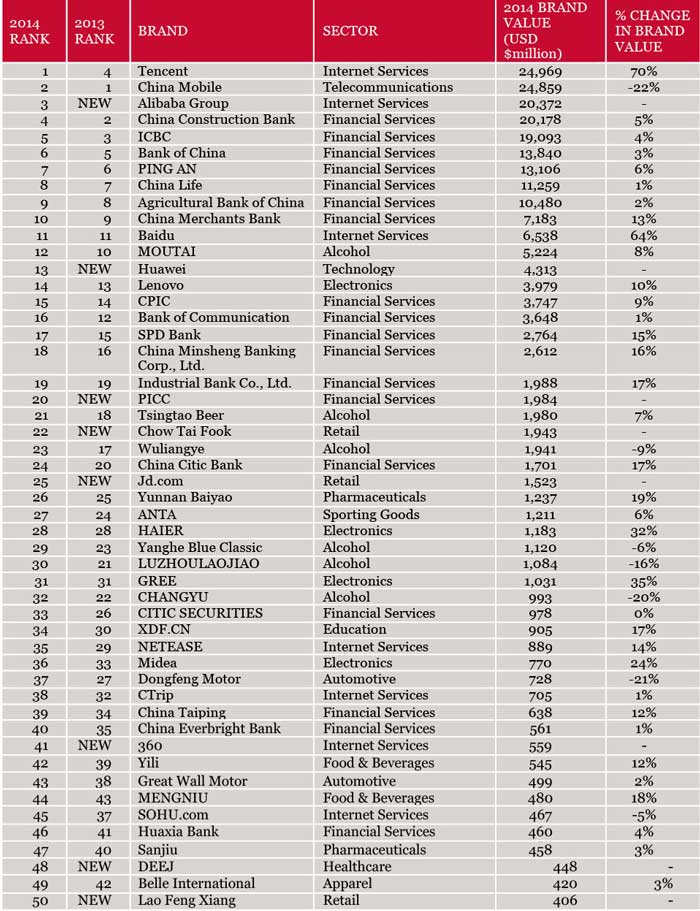
Interbrand, a brand consultancy company, released its 2014 Best China Brands report last week. Tencent claims the #1 position with China Mobile dropping to #2.
Eight brands entered the report this year, including Alibaba Group (#3), Huawei (#13), PICC (#20), Chow Tai Fook (#22), JD.Com (#25), 360 (#41), DEEJ (#48), Lao Feng Xiang (#50). In light of digital and mobile technology transforming the global marketplace, there appears to be increasing similarities between this year’s top Chinese brands and those brands recognized on the world stage.
“Brands across geographies have reached a pivotal point in terms of their development,” said Jez Frampton, Interbrand’s Global Chief Executive Officer. “They are entering what Interbrand has defined as the Age of You—and they are working to develop truly personalized and curated experiences around the individual consumer that this forthcoming age demands. Brands from all categories and sectors are getting “smarter” – with products and devices working in concert with one another, across supply chains and in tandem with our own individual data sets.”
The brand valuation methodology used for Best China Brands is the same methodology Interbrand uses to determine its annual Best Global Brands ranking. Interbrand examines three key aspects that contribute to a brand’s value:
- The financial performance of the branded product and service
- The role the brand plays in influencing customer choice
- The strength the brand has to command a premium price or secure earnings for the company.
The 2014 Best China Brands illustrate that those brands that have embedded technology and mobile applications throughout their core offerings have performed the strongest. Meanwhile, brands from more traditional industries demonstrated great potential as well. Overall, the total brand value of this year’s 50 Best China Brands increased 22 percent when compared to the total value of the 50 Best China Brands in 2013, representing the largest increase in the table’s overall brand value since the inception of Best China Brands. The strong performance of China’s Internet brands marks the end of an era for the financial services and telecommunication brands that had previously dominated the Best China Brands ranking.
With eight new brands making an appearance, the Best China Brands ranking has become more diversified and, consequently, Interbrand has been able to identify the following emerging trends:
The new ecosystem is cultivating the growth of super brands.
The total brand value of Internet brands has increased from 11 percent to 24 percent compared to last year, making the industry the second most valuable after the financial services industry. TAB (Tencent, Alibaba and Baidu), in particular, are either cooperating with or surpassing traditional industries in changing how consumers live, work, learn, and connect with each other and the world at large. Since the second half of 2012, TAB has acquired and invested in a wide-range of companies, including those representing the following sectors and industries: financial services, entertainment, education, and healthcare. As a result, these leading brands are creating entirely new brand ecosystems aimed at improving customer convenience and overall quality of life for all.
Mobile Internet, the Internet of Things, and Big Data have equipped brands with the power to change the word.
Mobile Internet, the Internet of Things, and Big Data not only provide opportunities for revolutionizing and changing traditional industries and Internet brands, but have also created greater synergy as a result of cross-platform collaborations—propelling the transformation and progress of society on a larger scale. Huawei, Lenovo, Haier, Gree and Midea particularly stand out, as they continue to actively explore and develop the concept of “smart city” and “smart home.”
Banking and Telecom industries call for transformation—a test of foresight and innovative capability.
The growth rate of the banking industry (12 brands earned positions on this year’s Best China Brands ranking) continues to slow down with the top four banks garnering less than 5 percent growth in brand value. Both state-owned and private commercial banks face greater challenges and more competitive pressure than ever before and are urgently in need of a “second transformation.” Those banking brands that possess foresight and innovative capabilities have undergone transformation either on their own or by collaborating with another brand—and have maintained their double-digit growth as a result. The business of voice calls and text messages for the Chinese telecom industry continues to decline under the proliferation of Mobile Internet. Facing numerous difficulties, Chinese telecom brands have implemented a series of actions to accelerate transformation. Only time will tell if such actions are too little too late or have the desired impact.
In addition to the trends outlined above, the significant movement amongst the 2014 Best China Brands also reflects four key challenges that Chinese enterprises face in the age of mobile Internet:
Revisit the concept of the age of Mobile Internet
Many Chinese enterprises lack a deep understanding of brand strategy and digital strategy. Their knowledge of ‘digital’ is limited to brand communication channels (online ads, official Wechat and Weibo) and e-commerce channels. Chinese enterprises need to adjust their mindset in both strategies to executional levels in the Age of Mobile Internet.
Emphasize a brand’s authenticity and differentiation.
Building a brand requires the coordination of all departments. A marketing department could be responsible for brand communication, but if no other departments, including sales and operations for example, do not support the corresponding brand experience, it would result in an inconsistent brand experience for the users, thereby reducing the brand’s level of authenticity, Differentiation is the perceived difference and uniqueness of the brand vis-à-vis the competitors. Without clear brand differentiation, brands can only compete on price. A brand’s core competency has shifted from technological capability to the ability to influence customers and consumers. If a brand were to build on its authenticity and differentiate itself from out inside out, it holds greater potential to bring greater value to its brand.
Clarify the direction of brand development.
Compared to great international brands, Chinese brands have a tendency to lack a clear brand vision. A clear brand vision can give a brand depth and bring it to life, garnering recognition and loyalty from the public. In contrast, those organizations lacking clear brand vision can only compete on price and thereby must work all the harder to remain relevant in today’s rapidly-changing Chinese and global marketplaces.
“Imaginative” becomes a key challenge for Chinese brands.
Today, Chinese enterprises need to think about how to create new brand experiences with their consumers instead of simply answering consumers’ current needs. Therefore, Chinese organizations need to inject a tremendous amount of imagination into their brands and into the experiences they build around those brands.
“The reason why Chinese brands face so many challenges and are operationally big, while fundamentally weak, lies in the gap of authenticity, relevance and differentiation compared to world’s most influential and powerful global brands,” said James Wang, General Manager of Interbrand Beijing. “Many Chinese enterprises are still in the early stages of brand development, or what Interbrand calls the Age of Identity. However, with every great challenge there lies a great opportunity.”
Yao Chen Gang, General Manager of Interbrand Shanghai also noted, “The Age of Mobile Internet brings great opportunity for Chinese brands to outpace competitors. The annual shipments of Chinese 4G smartphones can surpass a hundred million. Based on the economic value brought by Mobile Internet, the scale of China will likely be 3 to 4 times of the United States in the future. In this age, brand owners should clarify the brand’s vision, infuse creativity and imagination, create a well-rounded brand experience and co-create value together with consumers. With Huawei becoming the first Chinese brand to enter the Best Global Brands ranking, we look forward to seeing many more Chinese brands earn a top position in the near future.

Click here to read the report in Chinese (PDF).
Stats of Top Selling Brands on Taobao/Tmall in 18 Categories in Sep 2014